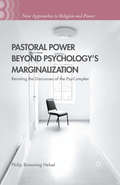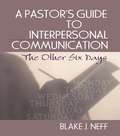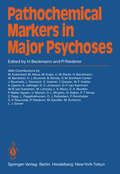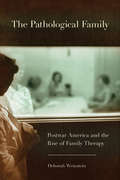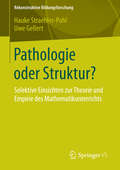- Table View
- List View
Pastoral Counseling: A Gestalt Approach
by Ward A Knights, Jr Harold G KoenigThis contemporary counseling approach seamlessly meshes with pastoral theology!Gestalt therapy is designed to be simple, free of jargon, and emotionally liberating--ideal for pastoral counseling in the context of a variety of faiths. This primer is designed to give pastors and rabbis a working knowledge of the basic techniques and attitudes pioneered by Dr. Fritz Perls. Pastoral Counseling: A Gestalt Approach shows how this holistic approach, with its emphasis on the here and now, is a natural counterpoint to pastoral theology. This comprehensive book gives specific instructions on using Gestalt techniques to increase the depth of the pastoral care and counseling you provide. Pastoral Counseling explains the basic goals of Gestalt work, which are to achieve spontaneity and expressiveness and to move toward personal authenticity. It also reveals how you can employ these techniques to help you and your congregation move toward realizing your God-given potential. Pastoral Counseling illustrates Gestalt theories from several perspectives, including: theory and techniques case studies a folk tale session transcripts a sermonPastoral Counseling guides you toward a broader understanding of the simple power of the holistic approach. Pastors and priests, rabbis, and other members of the clergy who engage in counseling will find its simple wisdom refreshing amidst the desert of dry theory. Gestalt counselors will find its pastoral perspective enlightening in their work with clients.
Pastoral Counseling: A Gestalt Approach
by Ward A Knights, Jr Harold G KoenigThis contemporary counseling approach seamlessly meshes with pastoral theology!Gestalt therapy is designed to be simple, free of jargon, and emotionally liberating--ideal for pastoral counseling in the context of a variety of faiths. This primer is designed to give pastors and rabbis a working knowledge of the basic techniques and attitudes pioneered by Dr. Fritz Perls. Pastoral Counseling: A Gestalt Approach shows how this holistic approach, with its emphasis on the here and now, is a natural counterpoint to pastoral theology. This comprehensive book gives specific instructions on using Gestalt techniques to increase the depth of the pastoral care and counseling you provide. Pastoral Counseling explains the basic goals of Gestalt work, which are to achieve spontaneity and expressiveness and to move toward personal authenticity. It also reveals how you can employ these techniques to help you and your congregation move toward realizing your God-given potential. Pastoral Counseling illustrates Gestalt theories from several perspectives, including: theory and techniques case studies a folk tale session transcripts a sermonPastoral Counseling guides you toward a broader understanding of the simple power of the holistic approach. Pastors and priests, rabbis, and other members of the clergy who engage in counseling will find its simple wisdom refreshing amidst the desert of dry theory. Gestalt counselors will find its pastoral perspective enlightening in their work with clients.
Pastoral Power Beyond Psychology's Marginalization: Resisting the Discourses of the Psy-Complex (New Approaches to Religion and Power)
by Philip Browning HelselThis book explores the suffering of social class and how traditional biomedical models for mental illness do not adequately account for the stresses of poverty. Turning to mental health user testimonies, this book equips ministers and counsellors to become working class advocates.
A Pastor's Guide to Interpersonal Communication: The Other Six Days
by Blake J. NeffImproving your powers of communication can encourage powerful communication with your parishioners. A Pastor’s Guide to Interpersonal Communication: The Other Six Days provides students preparing for the pastoral ministry with specialized training in communications that focuses on the kind of one-on-one conversations they can expect to have with their parishioners. This comprehensive book examines a variety of essential topics, including perception, self-disclosure, verbal and nonverbal messages, listening, stages of relational development, power assertiveness and dominance, conflict management, forgiveness, persuasion, dual relationships, pastoral family communication, and how to develop a communications model. Each chapter includes “Pastoral Conversations,” real-life dialogues presented for analysis; “Key Concepts” for quick student review; “Meanings Mania,” self-tests on vocabulary; and “Unleashing the Power of Interpersonal Communication,” student exercises that reinforce the practical aspects of key principles. While many pastors have a great love for the people they minister to, they have difficulty demonstrating that love because they lack the skills to develop and maintain relationships. This book explores how communication works and how to make it work for you, applying the best available interpersonal communications techniques to your relationships with the real people of the church—your parishioners. A Pastor’s Guide to Interpersonal Communication: The Other Six Days examines: how self-disclosure works and when it’s appropriate for a pastor stumbling blocks and building blocks for effective listening the differences between power, assertiveness, and dominance and when to use each conflict management styles and negotiation strategies several myths about forgiveness dual relationships and how to avoid them pitfalls to avoid in pastoral family communication and much more A Pastor’s Guide to Interpersonal Communication: The Other Six Days is an essential resource for Bible college students and for students at the pre-ministerial and seminary levels. It’s also a valuable professional tool for clergy practitioners who need help with their communication skills.
A Pastor's Guide to Interpersonal Communication: The Other Six Days
by Blake J. NeffImproving your powers of communication can encourage powerful communication with your parishioners. A Pastor’s Guide to Interpersonal Communication: The Other Six Days provides students preparing for the pastoral ministry with specialized training in communications that focuses on the kind of one-on-one conversations they can expect to have with their parishioners. This comprehensive book examines a variety of essential topics, including perception, self-disclosure, verbal and nonverbal messages, listening, stages of relational development, power assertiveness and dominance, conflict management, forgiveness, persuasion, dual relationships, pastoral family communication, and how to develop a communications model. Each chapter includes “Pastoral Conversations,” real-life dialogues presented for analysis; “Key Concepts” for quick student review; “Meanings Mania,” self-tests on vocabulary; and “Unleashing the Power of Interpersonal Communication,” student exercises that reinforce the practical aspects of key principles. While many pastors have a great love for the people they minister to, they have difficulty demonstrating that love because they lack the skills to develop and maintain relationships. This book explores how communication works and how to make it work for you, applying the best available interpersonal communications techniques to your relationships with the real people of the church—your parishioners. A Pastor’s Guide to Interpersonal Communication: The Other Six Days examines: how self-disclosure works and when it’s appropriate for a pastor stumbling blocks and building blocks for effective listening the differences between power, assertiveness, and dominance and when to use each conflict management styles and negotiation strategies several myths about forgiveness dual relationships and how to avoid them pitfalls to avoid in pastoral family communication and much more A Pastor’s Guide to Interpersonal Communication: The Other Six Days is an essential resource for Bible college students and for students at the pre-ministerial and seminary levels. It’s also a valuable professional tool for clergy practitioners who need help with their communication skills.
Paternal Postnatal Psychiatric Illnesses: A Clinical Case Book
by Shaila Kulkarni MisriThis book is the first to present the current research showing that like mothers, some fathers struggle with postpartum psychiatric illnesses and have unique needs of their own. Each chapter opens with a case vignette that describes different psychopathologies in the father and demonstrates the unique struggles presented by each situation. The cases highlight social, emotional and cultural upheaval that fathers may experience during the postpartum period. Sections in each chapter include manifestations of their illness, DSM-5 diagnoses, case discussion, treatment interventions and recommendations for health care professionals. This volume also puts paternal postpartum depression into conversation with other psychiatric comorbidities, including various personality disorders, anxiety disorders, and addictions. The text also addresses the various stigmas associated with these unique cases and offers clinical pearls on how to treat these families while giving consideration to the needs of the family.Written by renown experts in postpartum health, Paternal Postnatal Psychiatric Illnesses is an excellent resource for psychiatrists, psychologists, family therapists, general practitioners, obstetricians, social workers, and all clinicians working with postpartum families.
The Path of Least Resistance: Learning to Become the Creative Force in Your Own Life
by Robert FritzThe Path of Least Resistance: Learning to Become the Creative Force in Your Own Life, Revised and Expanded discusses how humans can find inspiration in their own lives to drive creative process. This book discusses that by understanding the concept of structure, we can reorder the structural make-up of our lives; this idea helps clear the way to the path of least resistance that will lead to the manifestation of our most deeply held desires. This text will be of great use to individuals who seek to use their own lives as the driving force of their creative process.
A Path With A Heart: Ericksonian Utilization With Resistant and Chronic Clients
by Yvonne M. DolanFirst published in 1993. Routledge is an imprint of Taylor & Francis, an informa company.
A Path With A Heart: Ericksonian Utilization With Resistant and Chronic Clients
by Yvonne M. DolanFirst published in 1993. Routledge is an imprint of Taylor & Francis, an informa company.
Pathobiology of Alzheimer's Disease (Neuroscience Perspectives)
by Peter Jenner Alison M. Goate Frank AshallNeuroscience Perspectives provides multidisciplinary reviews of topics in one of the most diverse and rapidly advancing fields in the life sciences.Whether you are a new recruit to neuroscience, or an established expert, look to this series for 'one-stop' sources of the historical, physiological, pharmacological, biochemical, molecular biological and therapeutic aspects of chosen research areas.The last decade has seen tremendous advances in our understanding of the pathobiology of Alzheimer's disease. These will lead to the first generation of drugs aimed at prevention rather than cure. This book covers some of the most important and exciting of these advances, with chapters written by many of the leading researchers in the field.With genetic studies as a backbone to this volume many chapters are devoted to the function and regulation of amyloid b-protein precursor (APP) and apolipoprotein E (ApoE). Other chapters describe cell biological approaches helping to piece together the link between the genetic alterations and the phenotype we call Alzheimer's disease.Although APP and its proteolytic cleavage product, amyloid b-protein, do not answer all the questions, detailed research into this system has undoubtedly increased our knowledge of the pathobiology of AD and has lead to the identification of other risk factors. Understanding the role of ApoE in the pathology of Alzheimer's disease promises to open a whole new field in AD research.* * Reviews the current knowledge of the pathogenesis of Alzheimer's Disease from a clinical perspective to a genetic and cell biological perspective* A comprehensive description of the role of amyloid B-protein precursor in Alzheimer's disease.* Up-to-date research data* Clear illustrations complement the text
Pathochemical Markers in Major Psychoses
by M. AckenheilThis volume contains the proceedings of the symposium Pathochemical Markers in Major Psychoses, held in Vienna in July 1983. The development of biological markers in psychiatric diseases, par ticularly in the field of neurochemistry, has made substantial progress during recent years although the multiple mechanisms of mental illness are still not fully understood. The greatest contribution has come through the development of new therapeutic agents that not only pro vide invaluable help for psychiatric patients but also serve as chemical tools for the investigation of the biological mechanisms underlying the disease. The catecholamine and serotonin hypotheses for major psy choses have been of particular heuristic value and have stimulated im portant research. However, the scope of our scientific endeavours has to be broadened to include other putative biological causes of psychoses, e. g. , pathomorphological changes, aberrations in the metabolism of other amino acids and oflipids, or the formation of endogenous toxins. This book presents new selected studies of the pathochemical bases of schizophrenia and affective psychoses. Although several topics were inevitably not included in this symposium, we nevertheless hope that it represents an integration of basic pathomorphological research with current clinical findings in the area of pathochemical markers in psy chiatry. October 1984 HELMUT BECKMANN PETER RIEDERER Contents Neuromorphological Background of Pathochemical Studies in Major Psychoses K. JELLINGER (With I Figure) . . . . . . . . . . of Psychopathological Classification The Significance in Interpreting Biochemical Findings E. GABRIEL . . . . . . . . . . . . . . . . .
Pathological Altruism
by Francisco J. AyalaThe benefits of altruism and empathy are obvious. These qualities are so highly regarded and embedded in both secular and religious societies that it seems almost heretical to suggest they can cause harm. Like most good things, however, altruism can be distorted or taken to an unhealthy extreme. IPathological Altruism/I presents a number of new, thought-provoking theses that explore a range of hurtful effects of altruism and empathy. Pathologies of empathy, for example, may trigger depression as well as the burnout seen in healthcare professionals. The selflessness of patients with eating abnormalities forms an important aspect of those disorders. Hyperempathy - an excess of concern for what others think and how they feel - helps explain popular but poorly defined concepts such as codependency. In fact, pathological altruism, in the form of an unhealthy focus on others to the detriment of one's own needs, may underpin some personality disorders. Pathologies of altruism and empathy not only underlie health issues, but also a disparate slew of humankind's most troubled features, including genocide, suicide bombing, self-righteous political partisanship, and ineffective philanthropic and social programs that ultimately worsen the situations they are meant to aid. IPathological Altruism/I is a groundbreaking new book - the first to explore the negative aspects of altruism and empathy, seemingly uniformly positive traits. The contributing authors provide a scientific, social, and cultural foundation for the subject of pathological altruism, creating a new field of inquiry. Each author's approach points to one disturbing truth: what we value so much, the altruistic "good" side of human nature, can also have a dark side that we ignore at our peril.
Pathological Altruism
by David Sloan Wilson Barbara Oakley Guruprasad Madhavan Ariel KnafoThe benefits of altruism and empathy are obvious. These qualities are so highly regarded and embedded in both secular and religious societies that it seems almost heretical to suggest they can cause harm. Like most good things, however, altruism can be distorted or taken to an unhealthy extreme. Pathological Altruism presents a number of new, thought-provoking theses that explore a range of hurtful effects of altruism and empathy. Pathologies of empathy, for example, may trigger depression as well as the burnout seen in healthcare professionals. The selflessness of patients with eating abnormalities forms an important aspect of those disorders. Hyperempathy - an excess of concern for what others think and how they feel - helps explain popular but poorly defined concepts such as codependency. In fact, pathological altruism, in the form of an unhealthy focus on others to the detriment of one's own needs, may underpin some personality disorders. Pathologies of altruism and empathy not only underlie health issues, but also a disparate slew of humankind's most troubled features, including genocide, suicide bombing, self-righteous political partisanship, and ineffective philanthropic and social programs that ultimately worsen the situations they are meant to aid. Pathological Altruism is a groundbreaking new book - the first to explore the negative aspects of altruism and empathy, seemingly uniformly positive traits. The contributing authors provide a scientific, social, and cultural foundation for the subject of pathological altruism, creating a new field of inquiry. Each author's approach points to one disturbing truth: what we value so much, the altruistic "good" side of human nature, can also have a dark side that we ignore at our peril.
Pathological Child Psychiatry and the Medicalization of Childhood
by Sami TimimiCurrently, it is common practice among the child psychiatric establishment to prescribe powerful and potentially addictive drugs to children who have emotional or behavioural problems. Pathological Child Psychiatry and the Medicalization of Childhood is a strong challenge to this way of thinking.Sami Timimi uses a wide variety of sources that shape our understanding including his personal experiences to highlight the role of culture, beliefs, science, social hierarchy and power, in shaping our understanding of childhood problems and how to deal with them. He urges professionals who work with children to question their assumptions in a manner that will enable them to access a greater variety of potentially helpful therapeutic frameworks.Since the 1960s, psychiatry has had to learn to accommodate critical analysis of its beliefs and methods. The legitimacy of its core assumptions continues to be questioned. Now child psychiatry too must engage with such a debate, if it wishes to develop into a genuinely democratic and inclusive profession. Pathological Child Psychiatry and the Medicalization of Childhood will be of great interest to professionals and trainees in psychiatry and child psychiatry, social work, family therapy and other psychotherapies for children and adolescents.
Pathological Child Psychiatry and the Medicalization of Childhood
by Sami TimimiCurrently, it is common practice among the child psychiatric establishment to prescribe powerful and potentially addictive drugs to children who have emotional or behavioural problems. Pathological Child Psychiatry and the Medicalization of Childhood is a strong challenge to this way of thinking.Sami Timimi uses a wide variety of sources that shape our understanding including his personal experiences to highlight the role of culture, beliefs, science, social hierarchy and power, in shaping our understanding of childhood problems and how to deal with them. He urges professionals who work with children to question their assumptions in a manner that will enable them to access a greater variety of potentially helpful therapeutic frameworks.Since the 1960s, psychiatry has had to learn to accommodate critical analysis of its beliefs and methods. The legitimacy of its core assumptions continues to be questioned. Now child psychiatry too must engage with such a debate, if it wishes to develop into a genuinely democratic and inclusive profession. Pathological Child Psychiatry and the Medicalization of Childhood will be of great interest to professionals and trainees in psychiatry and child psychiatry, social work, family therapy and other psychotherapies for children and adolescents.
Pathological Demand Avoidance Syndrome - My Daughter is Not Naughty
by Jane Alison SherwinJane Alison Sherwin's honest and uplifting account provides insight into the challenges of bringing up a child with Pathological Demand Avoidance (PDA). After years of misdiagnosis, Jane's daughter, Mollie, was diagnosed with PDA at the age of seven, and we follow her experiences pre and post diagnosis to age 10 as she attends school, interacts with the outside world and approaches adolescence. Throughout, Jane provides commentary on her daughter's behaviour and the impact it has on her family, explaining the 'why' of PDA traits, including the need for control, meltdowns, obsessive behaviour and sensory issues. She reveals the strategies that have worked for Mollie and provides essential advice and information on obtaining a diagnosis and raising awareness of PDA. The book also includes an interview with Mollie. Full of advice and support, and with a focus on understanding the child and how he or she sees the world, this book will be of immeasurable value to the parents and families of children with PDA as well as the professionals working with them, particularly teachers and teaching assistants, SEN co-ordinators, psychologists, outreach workers and social workers.
The Pathological Family: Postwar America and the Rise of Family Therapy (Cornell Studies in the History of Psychiatry)
by Deborah WeinsteinWhile iconic popular images celebrated family life during the 1950s and 1960s, American families were simultaneously regarded as potentially menacing sources of social disruption. The history of family therapy makes the complicated power of the family at midcentury vividly apparent. Clinicians developed a new approach to psychotherapy that claimed to locate the cause and treatment of mental illness in observable patterns of family interaction and communication rather than in individual psyches. Drawing on cybernetics, systems theory, and the social and behavioral sciences, they ambitiously aimed to cure schizophrenia and stop juvenile delinquency. With particular sensitivity to the importance of scientific observation and visual technologies such as one-way mirrors and training films in shaping the young field, The Pathological Family examines how family therapy developed against the intellectual and cultural landscape of postwar America. As Deborah Weinstein shows, the midcentury expansion of America’s therapeutic culture and the postwar fixation on family life profoundly affected one another. Family therapists and other postwar commentators alike framed the promotion of democracy in the language of personality formation and psychological health forged in the crucible of the family. As therapists in this era shifted their clinical gaze to whole families, they nevertheless grappled in particular with the role played by mothers in the onset of their children’s aberrant behavior. Although attitudes toward family therapy have shifted during intervening generations, the relations between family and therapeutic culture remain salient today.
Pathological Lying, Accusation, and Swindling: A Study in Forensic Psychology
by William Healy Mary HealyPathological Potential of Neuroglia: Possible New Targets for Medical Intervention
by Vladimir Parpura Alexei VerkhratskyPathophysiological states, neurological and psychiatric diseases are almost universally considered from the neurocentric point of view, with neurons being the principal cellular element of pathological process. The brain homeostasis, which lies at the fulcrum of healthy brain function, the compromise of which invariably results in dysfunction/disease, however, is entirely controlled by neuroglia. It is becoming clear that neuroglial cells are involved in various aspects of initiation, progression and resolution of neuropathology. In this book we aim to integrate the body of information that has accumulated in recent years revealing the active role of glia in such pathophysiological processes. Understanding roles of glial cells in pathology will provide new targets for medical intervention and aide the development of much needed therapeutics. This book will be particularly useful for researchers, students, physicians and psychotherapists working in the field of neurobiology, neurology and psychiatry.
Pathological Self-Criticism: Assessment and Treatment (The Springer Series in Social Clinical Psychology)
by Raymond M. BergnerRaymond M. Bergner offers the first comprehensive reference to address the highly prevalent and debilitating forms of self-criticism. This resource features an extensive array of strategies for assessing these patterns as well as the factors maintaining them. In addition, the volume is complete with therapeutic intervention strategies to help patients abandon pathological self-critical practices. The author desribes a therapeutic relationship that greatly enchances the efficacy of the interventions mentioned throughout the book.
Pathologie: Neuropathologie (Pathologie)
by Günter Klöppel Hans H. Kreipe Wolfgang RemmeleDas Standardwerk liefert aktuelles, gesichertes Wissen der Neuropathologie: Im Vordergrund stehen die Morphologie, Pathogenese, Ätiologie und Diagnostik der Erkrankungen des zentralen und peripheren Nervensystems sowie der Skelettmuskulatur. Die 3. aktualisierte Auflage folgt in der Gestaltung der Vorauflage, berücksichtigt aber zahlreiche neue Krankheiten und Entitäten, die durch die Genetik oder Techniken der Immunhistochemie und Molekularbiologie neu entdeckt oder abgegrenzt worden sind. Mit vielen zusätzliche Abbildungen und Tabellen.
Pathologie der geschlechtlichen Identität: Transsexualismus und Homosexualität, Theorie, Klinik, Therapie
by A. SpringerPathologie des psychosomatischen Reaktionsmusters: Diagnose · Klinik · Therapie
by Peter GathmannAnhand der außergewöhnlich hohen Zahl von 3354 in neun Jahren untersuchten Patienten (ambulant, stationär und nachuntersucht) zeigt der Autor multifaktorielle Definitionen des pathologischen psychosomatischen Reaktionsmusters und des diagnostisch-therapeutischen Managements in der Psychosomatik. Die Besonderheit des Buches besteht darin, daß es die ambulanten und stationären Versorgungsstrategien kritisch und anhand einer ungewöhnlichen Fülle beweiskräftigen statistischen Materials untersucht. Als Erhebungsstrukturen werden EDV-reife Fragebögen (verwendet: interdisziplinärer Kurzfragebogen für Ambulanzen; Nachuntersuchungsfragebogen), mit progredienter Differenziertheit konzipiert, von denen der ausführlichste (unverwendet) modellhaft zur Diskussion steht. Da auch Daten zum konsultierenden und delegierenden Mediziner erhoben werden, ist die Basis gegeben, die zu einer Metaanalyse des "wer behandelt (oder nicht) welchen PPSRM-Patienten zu welchem Zeitpunkt, mit welchen Mitteln und welchem Erfolg" verwendet werden. Ziel dieses Buches ist eine Sensibilisierung des Mediziners und des medizinischen Helfers für Einsatz, Wirkungsweise und Ökonomie diagnostisch-therapeutischer psychosomatischer Strategien.
Pathologie oder Struktur?: Selektive Einsichten zur Theorie und Empirie des Mathematikunterrichts (Rekonstruktive Bildungsforschung #4)
by Hauke Straehler-Pohl Uwe GellertDer vorliegende Band thematisiert Einsichten in die Formen und Wirkungen der, zunächst abstrakten, Selektionsfunktion von Schule in ihrer Konkretisierung und Ausgestaltung im alltäglichen Schulunterricht. Im Zentrum der Überlegungen steht die Frage, wie sich das große Thema der Reproduktion sozialer Ungleichheit im Bildungswesen auf der Ebene von Unterricht darstellt. Existieren Handlungsmechanismen, welche SchülerInnen Möglichkeiten des Bildungserfolgs differentiell zuweisen? Wie gestalten sich diese? Und was ermöglicht ihre Wirksamkeit? Wenn sich im Unterricht tatsächlich eine Perpetuierung sozialer Hierarchien vollzieht, so müssen sich entsprechende Prozesse in der Kommunikation der am Unterricht Beteiligten nachweisen lassen.
Pathologies of the Mind/Body Interface: Exploring the Curious Domain of the Psychosomatic Disorders
by Richard L. KradinPatients suffering from psychosomatic disorders represent a formidable challenge. Psychosomatic disorders are common, and account for substantial personal discomfort, unnecessary medical expenditures, socioeconomic loss, and disability. They are challenging to diagnose, treat, and are rarely completely cured. Furthermore, they often provoke strong negative reactions from family, friends, and caregivers, who are unable to fathom their inconsistencies. Currently, little is known as to how they develop or why their symptoms tend to transform over time. In Pathologies of the Mind/Body Interface, Richard Kradin, a medical internist, pulmonologist, and psychoanalyst at a large Harvard hospital, examines the historical, philosophical, cultural, psychological, and neurobiological factors that contribute to the development of psychosomatic disorders. He focuses on the role that developmental stress and attachment disorders appear to play in increasing the risk of developing psychosomatic symptoms, and advises medical practitioners and psychologists on how to diagnose and treat them. Dr. Kradin suggests areas of importance for future medical and psychological research into the causes and treatments of these debilitating disorders.

